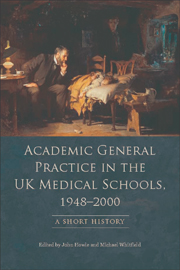Book contents
- Frontmatter
- Contents
- Preface
- Acknowledgements
- Abbreviations
- Timeline
- Introduction
- Dedication
- 1 The University of Aberdeen
- 2 The University of Dundee
- 3 The University of Edinburgh
- 4 The University of Glasgow
- 5 The Cardiff University School of Medicine
- 6 Academic General Practice in Ireland
- 7 The University of Birmingham
- 8 The University of Bristol
- 9 The University of Cambridge
- 10 The University of Exeter
- 11 The University of Leeds
- 12 The University of Leicester
- 13 The University of Liverpool
- 14 The University of Manchester
- 15 The University of Newcastle
- 16 The University of Nottingham
- 17 The University of Oxford
- 18 The University of Sheffield
- 19 The University of Southampton
- 20 The London Medical Schools
- 21 The University of St Andrews
- Appendix 1 Primary Care in the New Medical Schools
- Appendix 2 The SIFT/ACT Negotiations
- Appendix 3 An Overview
- Appendix 4 And Finally…
- Index
5 - The Cardiff University School of Medicine
Published online by Cambridge University Press: 05 August 2013
- Frontmatter
- Contents
- Preface
- Acknowledgements
- Abbreviations
- Timeline
- Introduction
- Dedication
- 1 The University of Aberdeen
- 2 The University of Dundee
- 3 The University of Edinburgh
- 4 The University of Glasgow
- 5 The Cardiff University School of Medicine
- 6 Academic General Practice in Ireland
- 7 The University of Birmingham
- 8 The University of Bristol
- 9 The University of Cambridge
- 10 The University of Exeter
- 11 The University of Leeds
- 12 The University of Leicester
- 13 The University of Liverpool
- 14 The University of Manchester
- 15 The University of Newcastle
- 16 The University of Nottingham
- 17 The University of Oxford
- 18 The University of Sheffield
- 19 The University of Southampton
- 20 The London Medical Schools
- 21 The University of St Andrews
- Appendix 1 Primary Care in the New Medical Schools
- Appendix 2 The SIFT/ACT Negotiations
- Appendix 3 An Overview
- Appendix 4 And Finally…
- Index
Summary
A medical school associated with Archie Cochrane's MRC epidemiology research unit and Professor C.R. Lowe's multidisciplinary university department of social and occupational medicine was ideally placed to develop academic general practice as an interface between biomedicine and community medicine. In 1968, Robert Harvard Davis, an Oxford graduate and general practitioner in Cardiff, was appointed to Professor Lowe's department to establish an academic unit of general practice with teaching and research responsibilities. He established a presence in the department of social and occupational medicine and then negotiated with Cardiff City Council to co-fund the building of an academic health centre on a new housing estate (Llanedeyrn) on the outskirts of Cardiff. The Welsh National School of Medicine (part of the University of Wales) supported the development and backed Harvard Davis as he raised charitable money and secured NHS cooperation in the establishment of a model NHS general practice that served the population of the Llanedeyrn area and provided clinical teaching for medical students. Facilities for general practitioners, nurses, health visitors, social workers, physiotherapy and pharmacy were included in the building plans: a model for teamwork.
A temporary building provided accommodation for the rapidly growing practice until 1971 when Llanedeyrn Health Centre opened. It was staffed by a combination of young academic general practitioners who worked in the practice and for the university, together with some older practitioners who worked part-time in their own practices and part-time in the academic unit at Llanedeyrn. Most of the funding for these posts came from NHS sources during the 1970s, with minimal university funding.
- Type
- Chapter
- Information
- Academic General Practice in the UK Medical Schools, 1948-2000A Short History, pp. 19 - 22Publisher: Edinburgh University PressPrint publication year: 2011



